Please use this identifier to cite or link to this item:
https://hdl.handle.net/10316.2/44518| Title: | A model for identifying blow-up fire potential | Authors: | McRae, Richard H. D. Sharples, Jason J. Badlan, Rachel L. |
Keywords: | Extreme wildfire;blow-up fire;dynamic fire spread;deep flaming;atmospheric instability;vorticity-driven lateral spread | Issue Date: | 2018 | Publisher: | Imprensa da Universidade de Coimbra | Journal: | http://hdl.handle.net/10316.2/44517 | Abstract: | Australia’s fire services mitigate the risk to the community from wildfires in a manner that leaves minimal residual risk. This work is founded on forecasts of fire behaviour based on fuel, terrain and weather. Using steady-state fire behaviour equations, any given set of conditions permits a single expected fire behaviour prediction. Since 2001, Australia has been impacted with rapidly increasing frequency by a class of fires driven by a coupling of the fire with the atmosphere above the mixed layer. In their most extreme form, these fires produced pyroCbs. The continental climatology has four events in the satellite era up to 2001, but since then 56 further confirmed events. This change in frequency is considered to be due to climate change. Blowup events were seen to occur when a fire fire switches from normal linear flaming to areal flaming - over 5km flaming depth has been observed. If this happens in an unstable atmosphere, the plume forms a cloud before it mixes out. The latent heat of condensation then released allows a rapid escalation of fire intensity on the surface. Arising from the extreme wildfires that hit Canberra on 18 January 2003, a series studies have shown how these fires develop. These insights were used to develop a predictive model for these events. The Blow Up Fire Outlook (BUFO) model incorporates these in a process model that has been formally trialled. An extreme wildfire is defined here as one where one or more blow-up events occur before it is suppressed. Deep flaming events are known to be caused by: two steady-state processes (strong winds and wind changes), a set of dynamic processes (vorticity-driven lateral spread, eruptive spread, dense spotting), inappropriate use of ignition devices, and reburning of areas as new fuel becomes flammable with time. The BUFO model was run in trial mode in the Australian Capital Territory and New South Wales over three summers. The results indicated that the trial was successful, despite the small sample size involved. The POD was 100%, the FAR was 33% and the TNR was 100%. The model utilised weather forecast data from the Bureau of Meteorology, weather observations, terrain analysis data from the HighFire Risk project (www.highfirerisk.com.au) and fire information. It makes heavy use of remotely-sensed information. The model is designed to start if there is an uncontained wildfire with raised fire danger, and to ask questions that are either true or false. The answers form a path that either loops back (for the model to be re-run at a different time) or yields a prediction of the potential for a blow-up fire event. Most of the nine questions are required to assess the potential for the formation of deep flaming. So, given that most of the damage is caused by fires not covered by the standard toolbox used by fire services, BUFO is designed to augment the work of Fire Behaviour Analysts. We are working to increase its uptake across the sector. | URI: | https://hdl.handle.net/10316.2/44518 | ISSN: | 978-989-26-16-506 (PDF) | DOI: | 10.14195/978-989-26-16-506_1 | Rights: | open access |
| Appears in Collections: | Advances in forest fire research 2018 |
Files in This Item:
| File | Description | Size | Format | |
|---|---|---|---|---|
| a_model_for_identifying_blow-up_fire.pdf | 698.25 kB | Adobe PDF |  |
Items in DSpace are protected by copyright, with all rights reserved, unless otherwise indicated.
